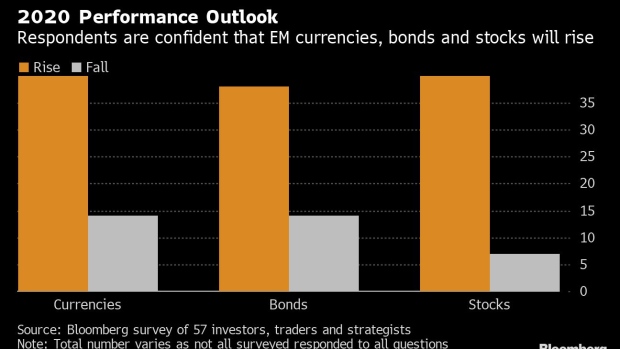Dec 10, 2019
The Emerging Market Rebound Looks Set to Stretch Into 2020
, Bloomberg News

(Bloomberg) -- Emerging markets are about to embark on another year of wealth creation after adding $11 trillion to investor portfolios in the past decade.
Developing-nation assets will outperform their developed peers, with Asia having the best prospects, according to Bloomberg’s survey of 57 global investors, strategists and traders on their outlook for next year. Total wealth in emerging-market stocks and bonds now exceeds $25 trillion, bigger than the economies of the U.S. and Germany combined.
The U.S.-China trade dispute that dictated market moves throughout 2019 will remain the biggest driving force, while China’s growth outlook eclipsed Federal Reserve monetary policy to be the second-most important factor. After a wave of global easing led to more than $11 trillion in negative-yielding debt, the haven pile will be less of a focus as some central banks enter holding patterns from easier monetary policies.
All emerging-market assets -- currencies, stocks and bonds -- are making a comeback this year after posting their largest losses in three years in 2018 as the Fed led global central banks in cutting benchmark rates to support flagging growth. Russia’s ruble, the best-performing emerging currency so far this year, overtook the Brazilian real to become the top pick in 2020, while Indonesia was the most favored for both bonds and stocks.
“I’m still quite bullish on emerging markets heading into 2020,” said Takeshi Yokouchi, a Tokyo-based senior fund manager at Sumitomo Mitsui DS Asset Management Co., which oversees the equivalent of $160 billion in assets. “Underlying supporting factors for EM still remain with very low rates globally, and that will encourage investors to look at higher-yielding assets.”
The combined equity values of 26 nations listed by MSCI Inc. as developing markets increased by $6.6 trillion since the end of 2009, according to data compiled by Bloomberg. Meanwhile, Bloomberg Barclays bond indexes that cover a larger swathe of emerging economies show that local-currency bonds added $2.9 trillion, U.S. dollar bonds added $1.7 trillion and euro-denominated securities added $237 billion during the period.
Below are the results of the Nov. 26-Dec. 5 survey. Click here to read the previous poll, and here is what we predicted for 2019.
Asia maintained its top position for currencies and stocks, while Latin America, which was plagued by a rise in political unrest this year, overtook Asia for bonds. Europe, the Middle East and Africa was the least favored for bonds and equities, but moved one notch up for currencies.
High-yielding assets dominated the top spots across the regions, underscoring continued demand.
Respondents were also asked about the outlook for inflation, monetary policy and economic growth across 12 emerging markets:
Click here for the list of survey participants.
--With assistance from Adrian Krajewski, Aline Oyamada, Áine Quinn, Andres Guerra Luz, Justin Villamil, Lilian Karunungan, Netty Ismail, Simon Flint, Sydney Maki, Srinivasan Sivabalan and Tomoko Yamazaki.
To contact the reporters on this story: Yumi Teso in Bangkok at yteso1@bloomberg.net;Marcus Wong in Singapore at mwong547@bloomberg.net;Selcuk Gokoluk in London at sgokoluk@bloomberg.net
To contact the editors responsible for this story: Tomoko Yamazaki at tyamazaki@bloomberg.net, ;Alex Nicholson at anicholson6@bloomberg.net, ;Carolina Wilson at cwilson166@bloomberg.net, Cormac Mullen
©2019 Bloomberg L.P.






